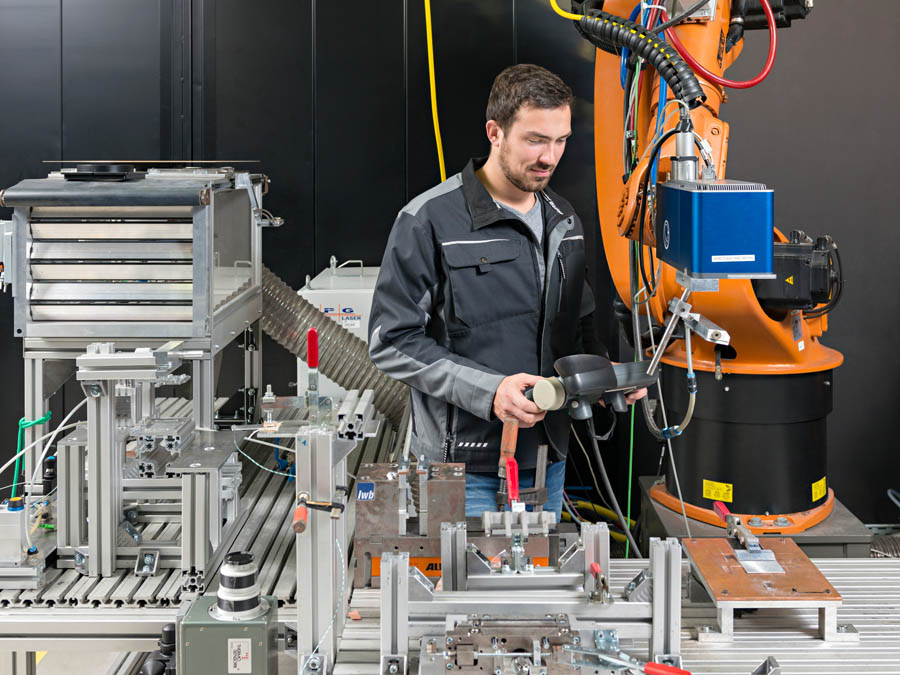TUM researchers work on joining techniques for lightweight materials
Seamless union between metals and plastics

Lightweight fabrication techniques offer huge potential for industry. Lighter automobiles and aircraft require less fuel, thereby reducing their CO2 emissions. Weight is a particularly important factor in electric cars, as the lighter the vehicle, the greater its range on a single battery charge.
Fiber-reinforced plastics are increasingly complementing light metals such as aluminum. Success lies in putting the right material in the right place. Metals are ideal where strong resistance to pressure and low elasticity are required – in screwed connections for example. But in complex products like automobiles, plastics are used alongside metals and both materials need to be joined together at certain points.
Alternative to adhesive and screws
The challenge lies in forming a firm and stable bond between plastic and metal components as efficiently and quickly as possible. "Up until now, adhesives were the favored means of achieving this", Alexander Fuchs from TUM’s Institute for Machine Tools and Industrial Management (iwb) explains. The downside of this process is that it is time-consuming. First of all, the adhesive has to be metered and applied. Then while it is hardening, the components have to be held securely in place.
Joining metal and plastic with screws and rivets also has downsides. The connection pieces add extra weight to the component. In addition, there is a risk that the holes will damage the structure and reduce the resistance of the fiber-reinforced plastic.
Laser surface treatment
The iwb is optimizing processes to securely fuse metals and thermoplastic (meltable) plastics by applying heat. The first stage involves texturing the metal surface with a laser beam, producing tiny hollows.
André Heckert, doctoral candidate at iwb, is looking at how different laser surface treatments influence the strength of the plastic-metal bond. Laser treatment can produce structures with a depth ranging from nanometers to a few millimeters. "The choice of surface structure for the best bonding properties depends on the material in question," explains Heckert.
He has discovered that a groove pattern a few tenths of a millimeter deep is particularly suitable for plastics reinforced with short fibers. By contrast, fine surface structures, which are generated with pulsed laser systems, are highly effective in the case of continuous fiber-reinforced plastics.
Quick and easy joining with NanoFoil
After the laser texturing stage, the metal and plastic materials are pressed together. The metal is now heated until the plastic melts and flows into the hollows. On cooling, a stable bond is formed between the two materials.
The scientists are using three different methods to create the necessary heat. Here again, a laser beam can generate enough heat to melt the plastic. In friction press joining, thermal energy is created by the friction of a cylindrical tool rotating on the metal surface under a defined pressure.
A completely different and very quick method relies on NanoFoil technology. When it ignites, NanoFoil can briefly reach a temperature as high as between 1,000 and 1,500 °C. This heat bonds the plastic and metal together. One possible application for this technology could be the fast joining of metal cable clips to an aircraft fuselage via a thermoplastic intermediate layer.
Contact:
André Heckert
Technical University of Munich
Institute for Machine Tools and Industrial Management
Tel.: +49 (0)89 289 155 89
E-Mail: Andre.Heckert@iwb.tum.de
www.iwb.tum.de/en/
Tanja Mayer
Technical University of Munich
Institute for Machine Tools and Industrial Management
Tel.: +49 (0)89 289 155 51
Tanja.Mayer@iwb.tum.de
Technical University of Munich
Corporate Communications Center
- Stefanie Reiffert
- reiffert@zv.tum.de
- presse@tum.de
- Teamwebsite

